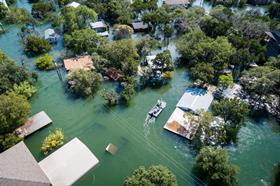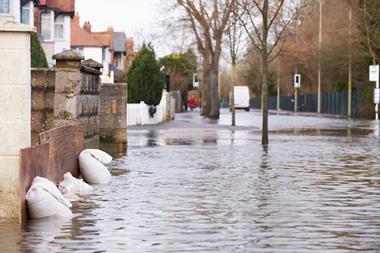Considering how the industry can rise to meet flooding challenges, parametric solutions are ‘giving people hope’, says consulting director and head of climate and catastrophe resilience
The “most thorny” issue for SMEs is getting cover for flooding. To practically resolve this problem, the insurance industry needs to think about whether the relationship between insurers and businesses is a risk partnership or transactional partnership, said Beverley Adams, consulting director and head of climate and catastrophe resilience at Marsh Risk Consulting.
She said: “The issue is difficulty getting cover, but the solution is probably more bound up with how we give insurers a very clear process and confidence that the actions that people are taking to install resilience really work and they’re measurable - very practically speaking, they can be used by underwriters to demonstrate their leadership.”
Adams, who was speaking at a webinar hosted by the ABI last month, added that “another [issue] I’ve come across recently is the split between landlord versus tenant responsibilities.
“It’s really unclear when you’re in a flood zone, who does what.”
A further challenge Adams identified surrounds ”the code of practice” (CoP). This refers to property flood resilience (PFR) measures that can be introduced for buildings at risk of flooding - these can be installed as part of the repair following a flood or in anticipation of a flood.
However, ”businesses are still not recovering resiliently [from flooding] because they don’t yet know about [the CoP],” Adams said.
“All of the practitioners - be it surveyors, be it loss adjusters - equally are not necessarily champing at the bit to get resilience worked in the right way, therefore they may have been flooded.”
Adams was joined in the panel debate by Denise Eastlake, head of the climate change desk at DAC Beachcroft, Andy Bord, chief executive of Flood Re, and Jeremy Ward, home insurance commercial director and product owner at Lloyds Banking Group.
The PFR CoP is made up of six standards. These are:
1. Hazard assessment – understanding how flooding may threaten a property.
2. Property survey – determining the design, materials, condition, orientation and exposure of buildings.
3. Options development – following a discussion with the end user, PFR measures are selected and specified for implementation.
4. Construction – construction activity to ensure that the PFR measures installed will deliver the levels of resistance and recoverability required to meet the needs of both the building(s) and end users.
5. Commissioning and handover – demonstrating that the construction activity and measures installed deliver the levels of PFR required by the end user.
6. Operation and maintenance – maintaining a level of protection.
Flood problem solving
Discussing solutions to the issues surrounding flooding, Adams said: “I think we need to embrace things like the Code of Practice, but also the new risks of property flood resilience scoring programme that we’re working on with Flood Re and [the] ABI.
“That’s the new focus of the Property Flood Resilience Roundtable. So, for all those people who score badly, if they then do resilience works, that should then adjust that bad scoring to make it look more viable.”
The Property Flood Resilience Roundtable is a private sector initiative supported by the government, which was created with the aim of collaborating key business interests to enable and encourage wider uptake of property flood resilience in the UK.
A similar initiative is the Task Force on Climate Related Financial Disclosures (TCFD), which was created by international body the Financial Stability Board in December 2015 to help prevent business losses as a result of natural disasters.

The force provides recommendations for more effective climate-related disclosures, aiming to promote more informed investment, credit and underwriting decisions.
Considering TCFD disclosures, Eastlake said: “Insurers themselves are doing this really well, but I would really encourage large corporate policyholders to really undertake that process themselves.
“If they don’t, they’re going to be left behind, just the way some [businesses] were left behind in the move to a digital economy.
“I know some [insurers] are doing it, but if they’re not, [they need to] really start the dialogue with their policyholders on disclosure and their transition pathways.
“So, how can businesses be scored on how they are transitioning because it’s essential - the sooner that starts, the more managed and controlled it can be and, therefore, the better for the economy it is, the better for that business it is and the better for the climate it is.
“The insurance industry is in an extremely powerful position to engage with its policyholders, to make sure that they transition.”
Another solution that can aid a risk partnership is parametric solutions, Adams and Eastlake agree.
Adams said that by the insurance industry providing “wonderful alternatives”, like the products that FloodFlash is creating, this is “giving people hope” because “people who haven’t been able to get traditional cover now have an option”, she explained.
She continued: “It’s so important that a parametric solution that kicks in at 20 centimetres is also aligned with resilience, because businesses have to cope with 20 centimetres.
“That’s something we can practically do – is keep those solutions coming but drive that marriage between the insurance, financing and also the operational bit, which is the resilience.”
Eastlake added: “I think [parametric solutions are] really exciting on the new products side.
“Aon said that there’s 64% global exposure for risks that don’t have access to insurance - there’s that protection gap, so parametric solutions are fantastic for that.”
“Climate change has [a] huge number of effects, so it’s not just flooding.”
Hosted by comedian and actor Tom Allen, 34 Gold, 23 Silver and 22 Bronze awards were handed out across an amazing 34 categories recognising brilliance and innovation right across the breadth of UK general insurance.




















































No comments yet